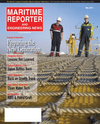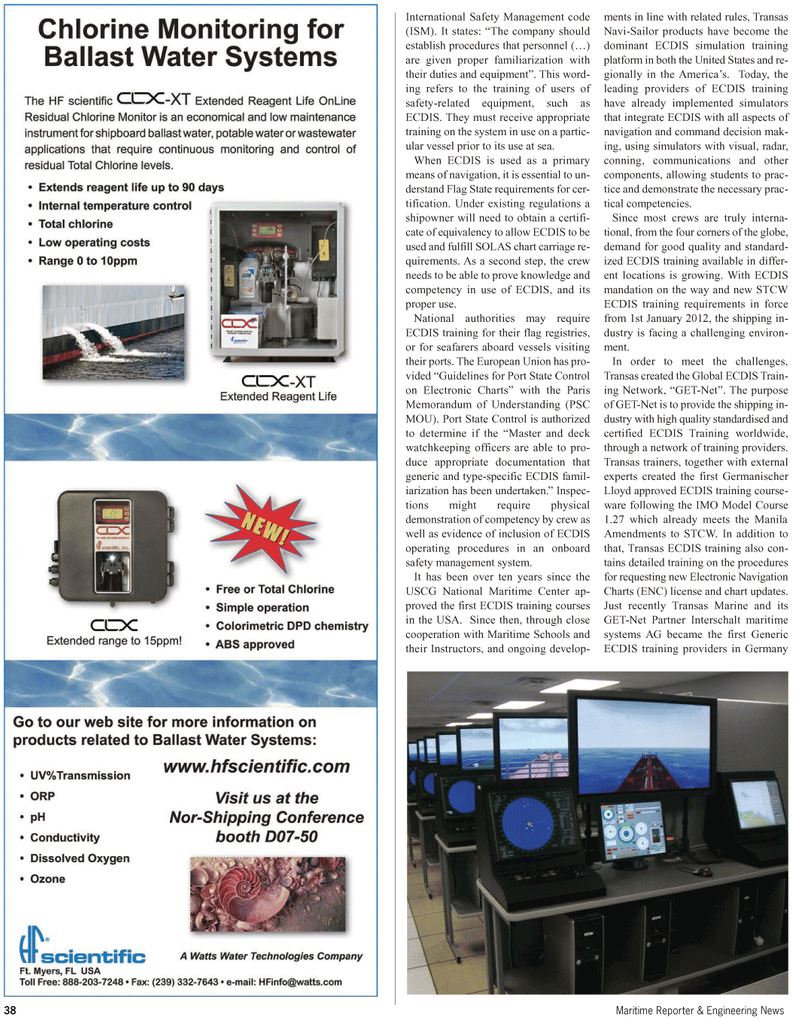
Page 38: of Maritime Reporter Magazine (May 2011)
Training & Education Edition
Read this page in Pdf, Flash or Html5 edition of May 2011 Maritime Reporter Magazine
International Safety Management code (ISM). It states: “The company should establish procedures that personnel (…) are given proper familiarization with their duties and equipment”. This word- ing refers to the training of users of safety-related equipment, such as
ECDIS. They must receive appropriate training on the system in use on a partic- ular vessel prior to its use at sea.
When ECDIS is used as a primary means of navigation, it is essential to un- derstand Flag State requirements for cer- tification. Under existing regulations a shipowner will need to obtain a certifi- cate of equivalency to allow ECDIS to be used and fulfill SOLAS chart carriage re- quirements. As a second step, the crew needs to be able to prove knowledge and competency in use of ECDIS, and its proper use.
National authorities may require
ECDIS training for their flag registries, or for seafarers aboard vessels visiting their ports. The European Union has pro- vided “Guidelines for Port State Control on Electronic Charts” with the Paris
Memorandum of Understanding (PSC
MOU). Port State Control is authorized to determine if the “Master and deck watchkeeping officers are able to pro- duce appropriate documentation that generic and type-specific ECDIS famil- iarization has been undertaken.” Inspec- tions might require physical demonstration of competency by crew as well as evidence of inclusion of ECDIS operating procedures in an onboard safety management system.
It has been over ten years since the
USCG National Maritime Center ap- proved the first ECDIS training courses in the USA. Since then, through close cooperation with Maritime Schools and their Instructors, and ongoing develop- ments in line with related rules, Transas
Navi-Sailor products have become the dominant ECDIS simulation training platform in both the United States and re- gionally in the America’s. Today, the leading providers of ECDIS training have already implemented simulators that integrate ECDIS with all aspects of navigation and command decision mak- ing, using simulators with visual, radar, conning, communications and other components, allowing students to prac- tice and demonstrate the necessary prac- tical competencies.
Since most crews are truly interna- tional, from the four corners of the globe, demand for good quality and standard- ized ECDIS training available in differ- ent locations is growing. With ECDIS mandation on the way and new STCW
ECDIS training requirements in force from 1st January 2012, the shipping in- dustry is facing a challenging environ- ment.
In order to meet the challenges,
Transas created the Global ECDIS Train- ing Network, “GET-Net”. The purpose of GET-Net is to provide the shipping in- dustry with high quality standardised and certified ECDIS Training worldwide, through a network of training providers.
Transas trainers, together with external experts created the first Germanischer
Lloyd approved ECDIS training course- ware following the IMO Model Course 1.27 which already meets the Manila
Amendments to STCW. In addition to that, Transas ECDIS training also con- tains detailed training on the procedures for requesting new Electronic Navigation
Charts (ENC) license and chart updates.
Just recently Transas Marine and its
GET-Net Partner Interschalt maritime systems AG became the first Generic
ECDIS training providers in Germany 38 Maritime Reporter & Engineering News

 37
37

 39
39
